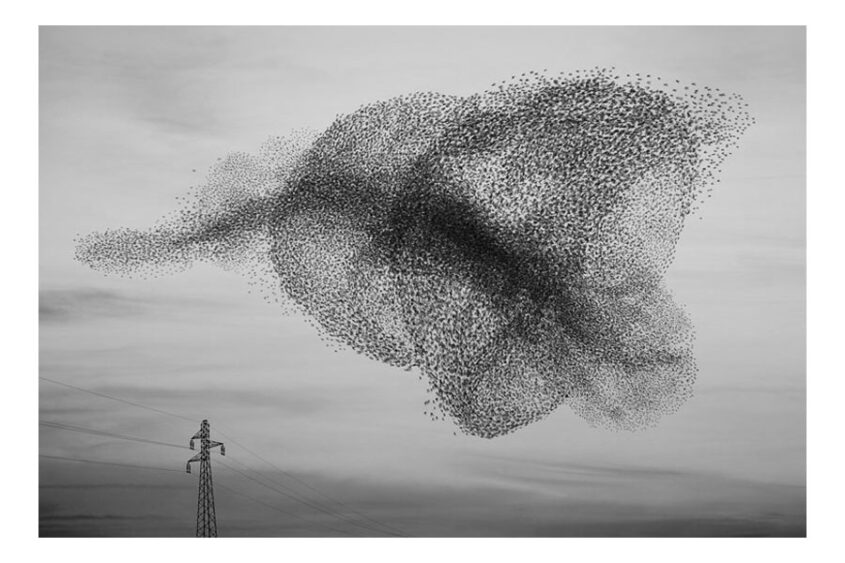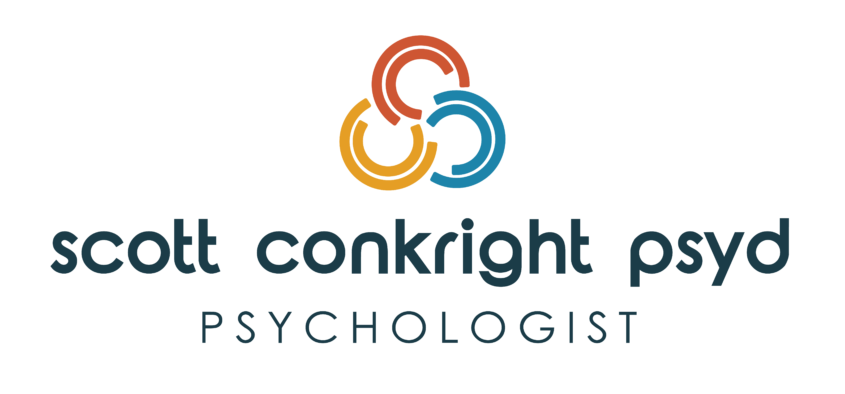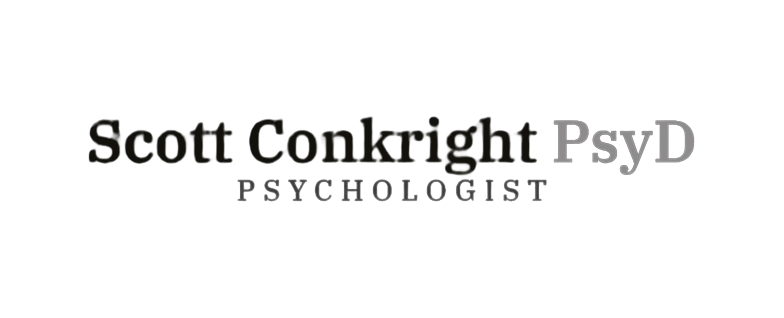Murmurations: An Introduction to Dynamic Vitality Affects

Imagine standing on a breezy hill at dusk, watching a flock of birds dance across the sky. Each bird, seemingly mindful of its neighbors, moves in a harmonious ballet of dips, rises, splits, and converges. This mesmerizing natural spectacle, known as a murmuration, is a wonder of nature and the inspiration behind the Boids algorithm, developed by Craig Reynolds in 1986.
The Boids algorithm is a beautifully simple model that simulates this flocking behavior. At its core, it relies on three straightforward rules that guide each ‘boid’—a playful abbreviation for ‘bird-oid object,’ akin to a virtual bird. These rules are:
- Separation: Just as birds maintain a comfortable distance from one another to avoid crowding, each virtual boid steers clear of its neighbors, ensuring there’s enough room to maneuver without collision. This rule mimics the personal space we instinctively preserve around us, preventing us from bumping into others as we move through crowded spaces.
- Alignment: Observe how birds in a flock seem to share a common direction, each aligning its flight path with those around it. The boids do the same, adjusting their movements to match the average heading of their neighbors. This rule reflects how humans often subconsciously mirror the attitudes and behaviors of those we find ourselves with, creating a sense of unity and shared purpose.
- Cohesion: Despite their movements, birds in a flock stay close, moving as one entity. Each boid in the algorithm is drawn towards its neighbors’ average position, maintaining the flock’s integrity. This behavior echoes our human desire to belong and maintain connections with our community, pulling us toward our social centers even as we assert our independence.
Despite its simplicity, the Boids algorithm generates complex, dynamic patterns that are astonishingly lifelike. Watching a simulation of boids is like watching that flock of birds on the hill—each movement individual, yet part of a larger, cohesive pattern. This is where its beauty lies; from a few simple rules, a rich tapestry of group dynamics emerges that mirrors the social behaviors and emotional dynamics we observe in human interactions.
In this light, the Boids algorithm is a powerful analogy for understanding how individuals navigate social spaces. Just as each boid’s behavior is influenced by its immediate neighbors, our actions and emotional states are often shaped by those around us, whether we’re moving through a crowded room, aligning with the mood of a group, or seeking connection within our communities. Through this lens, the algorithm simulates the physical world. It offers insights into the invisible forces that drive our social interactions, making it a poignant metaphor for exploring the complexities of human behavior and emotion.
Just as the Boids algorithm reveals the intricate dance of a flock through simple rules, affect theory peels back the layers of human emotion to uncover the fundamental forces that drive us. At the heart of affect theory is the concept of innate affects—nine primary, biological responses we’re born with, which are the building blocks of our emotions and personality. Much like the individual boids, these effects respond to the world around us in predictable ways yet combine to create the rich permutations of human “felt experience.”
Exploring the psychological themes of separation, alignment, and cohesion through the lens of human development, mainly through the Tomkins blueprint and the nine innate affects, offers a rich understanding of our conflicting needs for exploration, agency, and safety. These innate affects, present from birth, play a fundamental role in navigating our world, influencing our emotional and personality development through a complex interplay with our life experiences.
Separation: The Push for Exploration and Agency
Separation, in the psychological sense, is a crucial aspect of human development. It represents our need for exploration and agency, a journey that begins in infancy and continues throughout our lives. The innate affect of Interest-Excitement is central to this process. It fuels our curiosity and desire for mastery over our environment, encouraging us to venture into the unknown, learn new skills, and assert our individuality. This affect is inherently rewarding, making the act of exploration and the exercise of agency pleasurable, motivating continued engagement with the world around us.
However, the journey towards exploration and agency has its challenges. The affects of Distress-Anguish and Fear-Terror can be triggered when exploration leads to overwhelming situations or perceived threats. These affects serve as a counterbalance, reminding us of our vulnerabilities and the need for safety. Thus, even as we push for separation and independence, there is an underlying tension with our innate need for connection and protection.
Alignment: The Drive for Connection and Safety
Alignment speaks to our deep-seated need for connection, safety, and belonging. The innate affects of Enjoyment-Joy and Shame-Humiliation are particularly relevant here. Enjoyment-Joy fosters social bonds and attachments, highlighting the rewarding nature of positive interactions and shared experiences. Through this affect, we find comfort in familiarity, develop trust, and build a sense of belonging within our social groups.
On the other hand, Shame-Humiliation acts as a regulatory mechanism, signaling when our actions or others disrupt these connections or threaten our sense of belonging. It motivates us to modify our behavior to realign with our social groups and the expectations placed upon us, thus ensuring our actions are in harmony with those around us. This affect underscores the importance of social cohesion and the maintenance of social bonds, even at the expense of individual agency or exploration in specific contexts.
Cohesion: Balancing Exploration, Agency, and Safety
Cohesion represents the dynamic equilibrium we strive to achieve between our exploration, agency, and safety needs. We navigate the tensions between these needs through the complex interplay of all nine innate affects. Surprise-Startle acts as a reset button, allowing us to pivot and adapt to new information or changes in our environment, supporting our exploratory impulses and our need for stability.
The Tomkins blueprint, emphasizing maximizing positive and minimizing negative affect while expressing all affect, provides a foundational strategy for achieving this balance. By engaging with the world in a way that seeks to amplify interest and enjoyment while managing distress, fear, and shame, we can pursue exploration and assert our agency without losing sight of the importance of connection, safety, and belonging.
In essence, the nine innate affects and their role in human development illustrate the complex, yet ultimately harmonious, dance between our desires for separation and alignment as we seek to create a cohesive sense of self that can navigate the challenges and opportunities of our lives. This framework deepens our understanding of psychological development and offers valuable insights into the universal human experience.
Imagine each affect as musical notes, distinct and resonant. From the first breath we take, these affects begin to play, guiding us toward pleasure and away from pain, from feeling states that are inherently rewarding or punishing, sending us off to explore, pulling us into the embrace of connection, and away from threat. They are the primal cries of distress when we’re in need, the spark of interest that drives us to explore, the warmth of joy in connection, the jolt of surprise that snaps us to attention, and the flush of shame that signals there’s a hindrance to feeling good.
These innate affects blend with our experiences, shaping and being shaped by them. An infant’s cry of distress, seeking comfort, lays the groundwork for learning trust and security. A spark of interest leads to discovery and mastery, fueling our passions and pursuits. Interest and enjoyment in connection become the foundation for relationships, while the experience of shame guides our understanding of social norms and our place within them.
Affects operate within and between us, echoing the alignment and cohesion of boids within their flock. Just as boids adjust their flight based on the movements of their neighbors, our affects respond to the expressions and emotions of those around us, leading to emotional contagion and social synchronization. A smile shared between friends can amplify joy, just as a shared challenge can distribute stress, binding us in a shared experience.
In social interaction, these affects are the undercurrents that guide our behaviors and interactions. The unseen forces draw us together in moments of joy, push us apart in times of distress, and align our emotions with those around us, creating a dynamic interplay of emotional states that defines the human social landscape.
Understanding affect theory is like understanding the programming that drives the boids algorithm. It offers a lens through which to view the essential yet profound elements that drive our emotions, behaviors, and the complex patterns of human relationships that emerge from them. Through this understanding, we gain a deeper appreciation for the innate responses that bind us, drive us, and guide us through the myriad experiences of our lives.
Exploring the connection between the Boids algorithm and affect theory unveils a fascinating parallel: both illuminate the complex dynamics of behavior and emotion that emerge from straightforward, foundational rules or responses. This comparison enriches our understanding of social behavior and emotional interplay and opens new avenues for examining human interactions in various contexts. Here’s how these insights can be applied to the workplace, intimate relationships, social media, and group psychotherapy.
Boids Algorithm and Affect Theory: A New Perspective
At first glance, the movement of birds in a flock and human emotional dynamics might seem worlds apart. Yet, the Boids algorithm, with its simple rules of separation, alignment, and cohesion, mirrors the way our innate affects guide us in a dance of social interaction and emotional expression. This algorithm doesn’t just simulate avian flocking; it metaphorically captures the essence of human connection, where each individual’s actions and emotions significantly influence the collective behavior. The algorithm also beautifully describes our competing emotional needs –
Application to the Workplace
In the workplace, the Boids algorithm and affect theory principles intersect in team dynamics and organizational culture. Separation reflects the need for individuality and personal space, preventing employees from feeling overwhelmed by collective pressures. Alignment can be seen in the adoption of shared goals and values, where the emotional tone set by leaders significantly sways the group’s morale and productivity. Cohesion is the drive that keeps the team united, fostering a sense of belonging and mutual support. Understanding these dynamics through the lens of the Boids algorithm and affect theory helps managers and teams create more harmonious and productive work environments.
Application to Intimate Relationships
The dance between separation, alignment, and cohesion is particularly poignant in intimate relationships. Each partner, like an individual boid, seeks a balance between maintaining their autonomy (separation) and synchronizing with their partner’s emotional state (alignment), all while striving to keep a close and unified bond (cohesion). The insights from affect theory illuminate how our deepest drives and emotions play into this balancing act, highlighting the importance of acknowledging and navigating each other’s emotional states to foster a healthy, supportive relationship.
Application to Social Media
The vast social media network is a global sky where digital murmurations occur. Here, the spread of ideas, emotions, and behaviors through likes, shares, and comments exemplifies the principles of alignment and cohesion on a massive scale. Just as boids align with and move toward the center of the flock, individuals on social media platforms often align their opinions and emotions with those of their networks, creating powerful waves of social influence and emotional contagion.
Application to Group Psychotherapy
Group psychotherapy presents a unique setting where the Boids algorithm and affect theory principles offer profound insights. In this context, the therapist navigates the group through its emotional and relational dynamics, fostering an environment where separation (individual boundaries), alignment (shared understanding and empathy), and cohesion (group unity and support) are carefully balanced. Understanding these dynamics can enhance the therapeutic process, helping individuals feel seen and supported while fostering a sense of collective healing and growth.
The analogy between the Boids algorithm and affect theory enriches our understanding of human behavior and emotional dynamics. By exploring how simple rules and fundamental emotional responses underpin complex social behaviors, we gain a deeper appreciation for the subtleties of human interaction. This perspective offers a novel lens through which to view our social and emotional worlds and provides practical insights into managing and enhancing our personal and professional relationships.
In the intricate ecosystem of the workplace, the interplay of emotions and behaviors can be beautifully illustrated through the lens of the Boids algorithm. This perspective offers a unique framework for understanding how the emotional climate of a team or organization is not just a byproduct of individual actions but emerges from the dynamic interactions among its members. Let’s delve into how the core principles of the Boids algorithm—separation, alignment, and cohesion—map onto workplace dynamics, shaping everything from productivity to morale.
Dynamic Vitality Affects and Productivity
Consider alignment in the context of the Boids algorithm, where each boid adjusts its direction to match the average heading of its neighbors. In a workplace, this translates to how enthusiasm, motivation, or even anxiety can ripple through a team. When a leader or a group of employees exhibit a high energy or commitment towards a project, it’s likely to inspire others, aligning the team’s overall mood and direction. This emotional contagion can significantly boost productivity and morale, driving the team towards shared goals. Conversely, widespread anxiety or negativity can misalign the team’s focus, potentially derailing projects and dampening spirits.
Fostering a Unified Team Spirit
Cohesion in the Boids model refers to the tendency of boids to move towards the average position of their neighbors, maintaining the flock’s unity. Applied to the workplace, cohesion represents the collective efforts of employees to stay connected and move together towards organizational objectives. It’s about creating a culture where collaboration and support are paramount, ensuring the team functions as a cohesive unit. This sense of belonging and mutual purpose is crucial for maintaining engagement and loyalty, as it aligns individual aspirations with the company’s vision, creating a robust and unified team spirit.
Separation: The Importance of Individual Autonomy
While alignment and cohesion are vital for teamwork and collective success, the principle of separation in the Boids algorithm highlights the importance of maintaining individual autonomy and emotional space. Just as boids keep a certain distance from each other to avoid a collision, employees need room to cultivate their ideas, express their concerns, and work independently when necessary. Respecting personal boundaries and acknowledging individual contributions fosters an environment of trust and empowerment. It allows employees to bring their unique perspectives and strengths to the table, enhancing creativity and innovation.
Balancing the Dynamics
The challenge in the workplace, much like in the Boids simulation, lies in balancing these dynamics. Too much cohesion without adequate separation can lead to groupthink, stifling innovation and individual initiative. Conversely, excessive emphasis on separation may undermine team unity and collaborative efforts. Finding the right balance ensures that the team remains agile, innovative, and cohesive, capable of navigating the complexities of the modern workplace with resilience and efficiency.
Viewing workplace dynamics through the prism of the Boids algorithm not only enriches our understanding of organizational behavior but also offers practical insights into managing and enhancing team performance. Leaders can create an environment where the organization and its members thrive by fostering alignment around shared goals, ensuring cohesion through a supportive culture, and respecting individual autonomy. This holistic approach acknowledges the profound impact of emotional dynamics on workplace outcomes, guiding strategies to harness these forces for collective success.
Application to Intimate Relationships
In intimate relationships, separation, alignment, and cohesion mirror the dance of autonomy, empathy, and connection. Affect theory helps explain how partners influence each other’s emotional states, striving for a balance between closeness and personal space, mirroring the fluid dynamics of a murmuration.
In intimate relationships, the dance between individuals can be poignantly understood through the lens of the Boids algorithm, intertwined with the insights of affect theory. This analogy highlights the intricate balance of autonomy, empathy, and connection that characterizes the dynamics between partners, akin to the fluid, synchronized movements of a murmuration in the sky.
Separation: The Dance of Autonomy
In intimate relationships, separation echoes the principle of maintaining individual space and autonomy, like boids navigate to avoid crowding each other. This separation is not about distance but respecting and supporting each other’s need for personal growth, identity, and independence. It’s the understanding that each partner has their passions, challenges, and paths to self-discovery. Affect theory elucidates how personal space allows individuals to process their emotions and experiences independently, fostering a healthier, more resilient relationship dynamic.
Alignment: The Power of Empathy
Alignment in intimate relationships translates to the shared direction and mutual understanding between partners, driven by the profound human capacity for empathy. Just as boids adjust their flight based on the movements of their neighbors, partners in a relationship tune into each other’s emotional states, thoughts, and desires. Affect theory offers insight into how this alignment of emotions and intentions is critical for creating a sense of unity and partnership. Shared laughter, mutual support during challenges, and alignment of future aspirations deepen the bond between partners.
Cohesion: The Bond of Connection
Cohesion represents the gravitational pull that keeps the relationship unified and directed towards a shared center. This is the emotional and physical closeness, the sense of belonging, and the commitment that binds partners. Affect theory sheds light on how positive affects, such as joy, interest, and love, are the glue that holds partners together, creating a secure base from which both can explore the world. Cohesion is the desire to return to each other’s arms, the feeling of ‘home’ in the other’s presence, and the mutual care that nurtures the relationship.
Balancing the Dynamics
The beauty and challenge of intimate relationships lie in balancing the dynamics of separation, alignment, and cohesion. Too much emphasis on autonomy (separation) without enough connection (cohesion) can lead to feelings of isolation and disconnection. Conversely, too much cohesion without sufficient autonomy can stifle individual growth and lead to dependency. The art of the relationship is in fluidly navigating these dynamics, allowing for moments of close connection, personal development, and empathy to understand and adjust to each other’s needs and emotions.
Viewing intimate relationships through the interplay of separation, alignment, and cohesion, as inspired by the Boids algorithm and affect theory, offers a rich framework for understanding the complex dance of partnership. It highlights the importance of maintaining individuality, fostering mutual understanding, and cultivating a deep, cohesive bond. This perspective encourages partners to be mindful of the dynamic balance that sustains love and connection over time, mirroring a murmuration’s beautiful, ever-changing patterns in flight.
Application to Social Media
Social media acts as a vast sky within which emotional murmurations can unfold. Posts, likes, and shares are individual movements, creating patterns of viral emotions and sentiments that ripple through communities. Understanding these dynamics through the Boids algorithm can shed light on how positive and negative affects spread with remarkable speed and scale.
With social media, the emotional dynamics of human interaction take flight in a manner strikingly reminiscent of murmurations, where each post, like, and share represents an individual movement contributing to larger patterns of viral emotions and sentiments. Through the lens of the Boids algorithm, we can gain profound insights into how these digital interactions lead to the swift and widespread propagation of affects across the online landscape.
Alignment: The Virality of Emotion
In social media, alignment parallels the phenomenon of emotional contagion, where the mood and sentiments of one post can influence many. Like how boids align their direction based on their neighbors, social media users often find their emotional states swayed by the content they encounter. Whether joyful or sorrowful, a highly expressive post acts like a strong current, pulling others into its flow. This alignment can lead to waves of positivity, such as solidarity in times of crisis or collective celebration of achievements. Still, it can amplify negative sentiments, such as fear during an emergency or outrage over social injustices.
Cohesion: Building Communities and Movements
Cohesion on social media is reflected in forming and strengthening communities and movements. Just as boids move towards the average position of their neighbors to maintain flock cohesion, individuals on social media gravitate towards groups and pages that resonate with their interests, beliefs, and values. This sense of belonging fosters strong community bonds and can mobilize collective action for social causes, fan-based communities, or support networks. These groups’ shared identity and purpose create a powerful force capable of initiating real-world change and providing a sense of unity and support among members.
Separation: The Need for Individual Voice and Space
Despite the strong currents of alignment and cohesion, social media also embodies the principle of separation, where individuals seek to maintain their unique voice and personal space amidst the vast digital crowd. This separation is crucial for diversity of thought and creativity, allowing multiple perspectives and narratives to coexist. The balance between authentically expressing oneself and belonging to a larger community fosters a dynamic and vibrant social media ecosystem.
Navigating the Dynamics
Understanding social media dynamics through the Boids algorithm illuminates the delicate balance between alignment, cohesion, and separation in the digital realm. It highlights the need for mindful engagement, recognizing the power of our digital interactions to influence emotions and shape perceptions. By fostering positive alignment, supporting cohesive communities, and respecting individual separation, users can contribute to a healthier, more supportive online environment.
Applying the Boids algorithm to social media dynamics offers a compelling framework for understanding the complex interplay of emotions and behaviors in the digital age. Just as a murmuration of starlings creates breathtaking patterns in the sky, the collective actions of social media users generate waves of emotional and cultural movement. Recognizing and navigating these dynamics can enhance our digital interactions, making social media a more positive and enriching space for all.
Application to Group Psychotherapy
Group psychotherapy presents a unique setting where the principles of the Boids algorithm and affect theory converge. Therapeutic groups can be seen as emotional flocks, where the therapist helps navigate the group through the complex dynamics of separation (establishing boundaries), alignment (fostering empathy), and cohesion (building a supportive community). This approach can enhance understanding and intervention strategies in therapeutic settings.
With its rich tapestry of interpersonal interactions and emotional exchanges, group psychotherapy is a fertile ground where the principles of the Boids algorithm and affect theory beautifully converge. Within this therapeutic milieu, participants can be likened to emotional flocks, navigating the complexities of human experience together under the guidance of a therapist who facilitates the group’s journey toward healing and growth. The dynamics of separation, alignment, and cohesion play pivotal roles in shaping the therapeutic process and outcomes.
Separation: Establishing Boundaries
In group psychotherapy, separation embodies the crucial task of establishing healthy boundaries between participants. Just as boids maintain a certain distance from one another to avoid collisions, members of a therapeutic group learn to recognize and respect their boundaries and those of others. This separation is vital, allowing individuals to explore and articulate their personal experiences and emotions in a space that honors their autonomy. The therapist’s role in reinforcing these boundaries helps prevent the blurring of individual identities and ensures that the therapeutic environment remains safe and respectful for all participants.
Alignment: Fostering Empathy
Alignment within group psychotherapy mirrors attuning and empathizing with other group members’ emotional states and perspectives. Similar to how boids adjust their movements to align with the direction of their neighbors, individuals in therapy groups learn to listen deeply and resonate with the experiences shared by their peers. This empathic alignment fosters shared understanding and solidarity, allowing group members to feel seen, heard, and validated in their experiences. The therapist facilitates this process by modeling empathic communication and encouraging a culture of mutual support and respect.
Cohesion: Building a Supportive Community
Cohesion in group psychotherapy is akin to the collective movement towards a common center that binds the members of a flock. In therapeutic groups, this principle manifests as developing a supportive, cohesive community where members work collaboratively towards common goals of healing and growth. The shared emotional journey of the group strengthens bonds between members, creating a powerful sense of belonging and togetherness. The therapist is crucial in nurturing this cohesion, guiding the group through challenges and conflicts, and reinforcing the collective commitment to the therapeutic process.
Navigating the Dynamics
Effectively navigating separation, alignment, and cohesion within group psychotherapy can significantly enhance therapeutic outcomes. By carefully managing these dynamics, therapists can create a balanced environment where individual autonomy is respected, empathy is cultivated, and a robust and supportive community is built. This balance enables group members to engage deeply in the therapeutic process, experiencing personal growth while also contributing to the collective healing of the group.
Applying the Boids algorithm and affect theory to group psychotherapy offers valuable insights into the complex dynamics at play within therapeutic groups. Viewing the group as an emotional flock, guided by separation, alignment, and cohesion principles, provides a framework for understanding and enhancing the therapeutic process. This approach deepens our comprehension of group dynamics and informs intervention strategies, ultimately contributing to more effective and meaningful therapeutic experiences.






